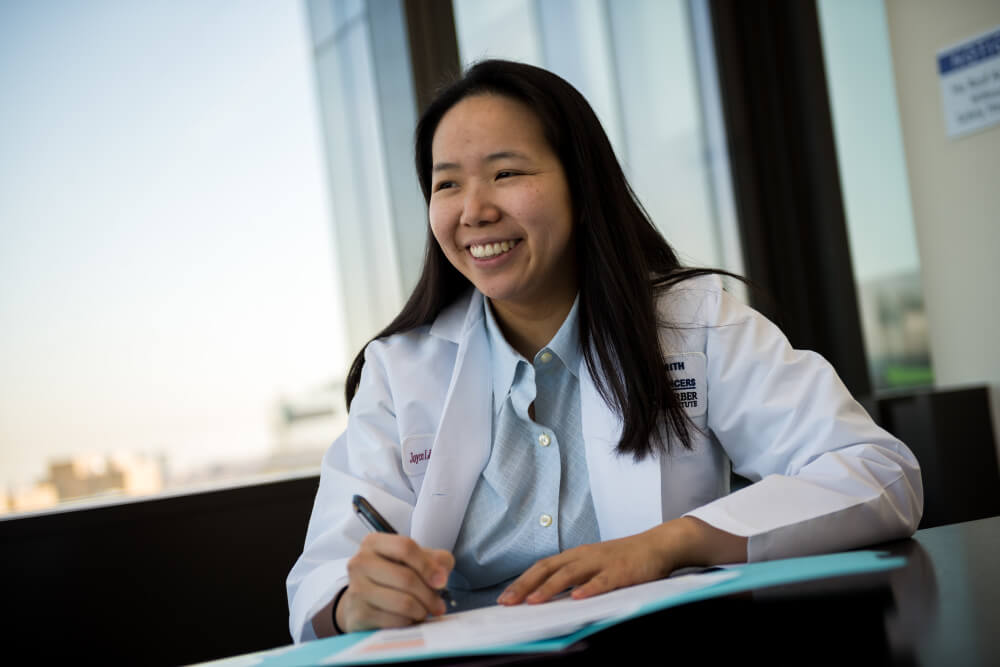The resilience shown by cancer care providers during the coronavirus crisis is in equal supply among those involved in clinical research.
The strict protocols associated with these studies — rules on eligibility, consent, criteria for tracking response, data collection and analysis — might seem to allow little of the flexibility needed in the COVID-19 era. But with technological and procedural workarounds, Dana-Farber clinical investigators and their teams have kept clinical trials on track and in compliance with the elaborate rules that govern them.
The most powerful sign of their success may be this: of the thousands of patients currently enrolled in clinical trials at the Institute, fewer than 10 have needed to drop out for logistical or transportation-related reasons since the coronavirus outbreak hit Boston in early March.
“Clinical trials are an integral part of caring for patients at Dana-Farber,” says Bruce Johnson, MD, chief clinical research officer at Dana-Farber. “Often, a therapy being tested in a trial is the best treatment available for particular patients. It’s critical to continue treating patients in clinical studies and enrolling them, while seeing to the safety of our staff and patients.”
A trend toward teleconferencing

Meetings between patients and their clinical research teams increasingly take place via teleconference to help reduce risk of exposure while also enabling patients to stay in frequent contact with research nurses, schedulers, and physicians.
To further reduce the need for patients on clinical trials to come to the Institute, trial staff are arranging for blood lab tests to be done at outside facilities, with the results sent to Dana-Farber for review. CT and other scans also can be performed offsite — the images mailed to Dana-Farber researchers on compact disc. For trials involving oral medications, drugs are now routinely sent to patients’ homes, rather than having to be picked up.
“Our research nurses, study coordinators, and schedulers coordinate these efforts,” says Joyce Liu, MD, MPH, director of clinical research in Gynecologic Oncology at Dana-Farber. “They work with patients, Pharmacy, trial leaders, and outside labs to ensure that lab tests are scheduled and performed, results are received, and that drugs are shipped at the time patients need them.”
When a patient needs an in-person appointment — for an exam or drug infusion, for example — trial teams meet in advance to ensure the visit runs as efficiently as possible.
“There’s a great deal of planning and strategizing,” Liu remarks. “We arrange for patients to be consented [to participate in the trial], see the physician, and complete all of the required tests to check for study eligibility in one visit, rather than in two visits, as we have sometimes done in the past.”
For patients who have recently completed a trial, follow-up visits are spaced further apart, where it’s safe to do so, sparing those who live far away the need to travel.
Amidst these changes, clinical trial regulatory teams, who handle the administrative, logistical, and regulatory aspects of a trial, have played a critical role. They’ve kept abreast of the flood of new policies and requirements issued by the U.S. Food and Drug Administration, the trial’s sponsor, the Institute itself, and then communicate them to the rest of the trial team.
Enrollment challenges — but preparing to hit the ground running

While investigators have gone to great lengths to keep current trials running, new restrictions have temporarily limited the enrollment of some patients and slowed the launching of new trials, Johnson remarks. This is particularly true for trials that require “research biopsies” for patients starting trials.
The collection and analysis of these small tissue samples are compared to those taken before and after treatment to assess the effectiveness of the therapy. Since the start of the outbreak, however, biopsies are not being performed for elective purposes, including those in clinical trials. In some cases, patients have been able to enroll based on samples obtained before or after their previous treatments.
The same restrictions have temporarily halted some of the “correlative research” within clinical trials. These studies don’t affect the treatment a patient receives while on trial but may involve a search for biomarkers of how well the patient is responding, or whether a treatment has sparked an immune response to the cancer.
In cases where the unavailability of biopsy testing has put enrollment of new patients on hold, investigators are continuing to identify suitable patients so they can start once the restrictions lift. This is the case with the PATHFINDER trial of a blood test for detecting early signs of cancer in people with no symptoms of the disease, says Geoffrey Oxnard, MD, the co-principal investigator of the study.
“We are consenting patients remotely and doing other preparatory work, so we can hit the ground running once lab testing re-starts,” he says.
Oxnard adds that many of the adjustments made in response to the COVID-19 pandemic — the increased use of telemedicine, for example — may be retained once the epidemic wanes.
“The fact that we’ve been able to make these changes successfully raises the possibility that they can be used in the future,” he comments.
